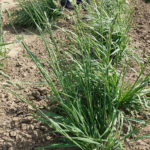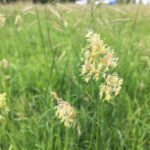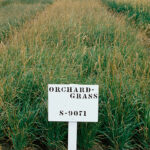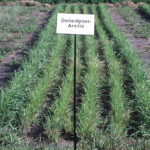Orchardgrass
Dactylis glomerata
General Description
Orchardgrass is a very productive, highly palatable, perennial bunchgrass. Root systems are extensive and fibrous with a distinctive bunch growth. Crowns increase in size over time through tiller production.
Stems are 100 cm (39 in) tall or more, and are distinctive in their flattening near the soil surface. Lots of basal leaves are produced, with smooth, folded leaves. Young leaves have boat-like tips, while older leaves have pointed tapered tips. Leaves are soft, hairless, light green to blue green and up to 1 cm (3/8 in) in width.
It has long, wide leaf blades and a coarsely tufted panicle. The cross-section of the stems is oval-shaped. The sheath is split part way and is green on the top and pale green or white on the lower part. The blade is 5-12.5 mm (1/4-1/2 in) wide and 7.5-40 cm (3-16 in) long. It is V-shaped Leaves are soft, hairless, light green to blue green and up to 1 cm (3/8 in) in width near the base, but flat towards the sharp, pointed tip. The yellow-green collar is broad and divided by a midrib. There are no auricles. The ligule is a white membrane that usually has an awn-like point at the top. The stems are flat and 90-150 cm (36-60 in) tall. The inflorescence is a panicle made.
Seed heads are up to 20 cm (8 in) long with clustered spikelets. Seeds are small but light, awned and chaffy. Orchardgrass is widespread in fields, meadows, and roadsides in regions with high annual rainfall.
Type
Tame grass.
Origin
Europe, Africa, and Asia. Varieties developed in Canada.
Longevity
At least 5 years. Persistence of orchardgrass is very dependent on the ecosystem and variety.
Use
Pasture, hay. Can be grazed in a rotational or continuous grazing system. Orchardgrass is also commonly used for seeding of roadsides, log landings, skid trails, and forested sites. Orchardgrass is fine-leaved and does not stand up to late fall/ winter stockpiled grazing.
Optimal Time of Use
Summer, fall. Can be grazed in the late spring once plants reach 20 to 25 cm (8 to 10 in) in height, and repeatedly through mid-autumn. It can be grazed later in the fall, but should be left to accumulate reserves in late summer and early fall. Orchargrass should be cut for hay at early heading.
Recovery After Use
Requires a minimum 30-45 days of recovery after use. Adequate moisture and fertility are needed for quick recovery. In the drier dark brown soil zone longer recovery periods are needed. Regrowth after haying is often grazed. If livestock are allowed to continuously graze orchardgrass, stocking rates should be matched to production so it is grazed lightly and not too closely.
Adequate moisture and fertility are needed for quick recovery. In the drier dark brown soil zone longer recovery periods are needed. Regrowth after haying is often grazed. If livestock are allowed to continuously graze orchardgrass, stocking rates should be matched to production so it is grazed lightly and not too closely.
Palatability/Nutritional Value
Orchard grass is one of the most palatable tame grasses. Crude protein ranges from 13 to 15% and digestibility is approximately 67% when in vegetative stage. Quality drops off quickly when it forms seed heads. Livestock do very well on orchardgrass and seek it out in mixed stands.
Annual Precipitation min/max (mm)
400mm / 1650mm
Drought Tolerance
Moderate tolerance. Orchardgrass is more drought tolerant than timothy, but not as much as bromegrasses. However, once a dry period ends, it can recover quickly.
Flooding Tolerance
Withstands 1-2 weeks of spring flooding. Does best with high annual rainfall.
Winter Hardiness
Fair to good hardiness. Winter hardiness is dependent on snow cover conditions, carryover stubble height, and variety improvements. Orchardgrass winter hardiness has been good in the Peace River Region even with little snow cover. Carry over stubble height should be should be at least 20 cm (8 in) in colder regions. In most regions, select an orchardgrass variety noted for hardiness.
Soil Texture Preference
Orchard grass is suited to loamy to clay soils with a high water holding capacity, and does well in areas with high precipitation.
Erosion Control
No erosion control.
Salinity Tolerance
No salinity tolerance.
Acidity Tolerance
Moderate tolerance. Tolerates soil pH levels as low as 5.0.
Alkalinity Tolerance
Low tolerance.
Seeds per kg
942,000 seeds/kg (427,000 seeds/lb)
Suggested Mixtures
Often is included as a small proportion of a mix to serve as a higher producing grass while others establish. Mix with legumes such as alfalfa, cicer milkvetch, sainfoin or the clovers, and other grasses such as the bromegrasses, northern wheatgrass, tall fescue, slender wheatgrass or timothy.
Often is included as a small proportion of a mix to serve as a higher producing grass while others establish. Mix with legumes such as alfalfa, clovers, and other grasses such as the bromegrasses, tall fescue, or timothy.
Ease of Establishment
Orchardgrass grows as vigorous seedlings that establish quickly, are shade tolerant, and will tolerate a companion or nurse crop. Spring growth thereafter is slower than other grasses. Orchardgrass seed viability declines rapidly in storage.
Competitiveness
Lack of winter hardiness may limit competitiveness in colder areas. In southern interior regions orchardgrass will co-exist with native species in most ecosystems. Orchardgrass is generally considered to be non-invasive.
Lack of winter hardiness may limit competiveness in colder areas. Orchardgrass is generally considered to be non-invasive, In more complex mixtures, 3.5-4.5 kg/ha (3-4 lb/acre) is sufficient. Its aggressive seedlings make orchardgrass easy to establish.
Management Considerations
Orchardgrass responds well to nitrogen fertilizer and is most productive overall with rotational grazing. Orchardgrass must go into the winter with enough residue to store carbohydrates in the stem to survive. Leaving standing residue over winter can help increase snow cover which is important to insulate the crowns. Select varieties with noted winter hardiness.
British Columbia Rangeland Seeding Manual, Saskatchewan Dryland Forage Species Adaptation Tool, USDA Plants Database, Manitoba Forage Adaptation and Comparison Guide, Alberta Forage Manual
Orchardgrass is adapted to the Sub-Boreal Spruce, Interior Cedar-Hemlock and Sub-Boreal Pine-Spruce zones. In the southern part of the Central Interior region, it is adapted to wetter parts of the Interior Douglas-fir zone and to irrigated and subirrigated areas in the Bunchgrass zone and drier parts of the Interior Douglas-fir zone.
Orchardgrass is adapted to dryland applications in the wetter parts of the Interior Douglas-fir zone, the Interior Cedar-Hemlock zone, and to irrigated and subirrigated areas in the Bunchgrass, Ponderosa Pine zones and drier parts of the Interior Douglas-fir zone.
Orchardgrass is adapted to warmer, sheltered sites in the Peace-Liard region. It is important to choose varieties noted for winter hardiness. On marginal sites, orchardgrass may not be as competitive as other species and may not persist in a stand.



